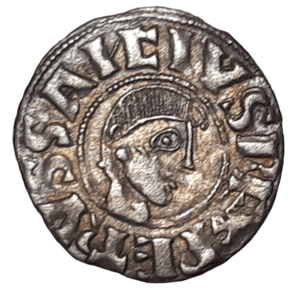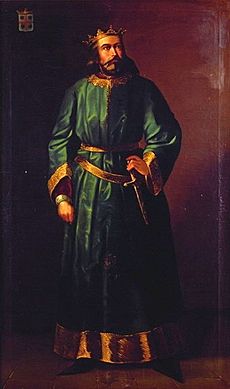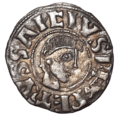Peter I of Aragon and Pamplona facts for kids
Quick facts for kids Peter I |
|
|---|---|

Peter's effigy on a coin
|
|
| King of Aragon and Pamplona | |
| Reign | 1094 - 1104 |
| Predecessor | Sancho Ramírez |
| Successor | Alfonso the Battler |
| Born | c. 1068 |
| Died | 1104 |
| Burial | Royal Monastery of San Juan de la Peña |
| Spouse | Agnes of Aquitaine Bertha of Aragon |
| House | Jiménez |
| Father | Sancho Ramírez |
| Mother | Isabella of Urgell |
| Religion | Catholicism |
Peter I (also known as Pedro or Pero) was a powerful king who ruled Aragon and Pamplona (which is now part of Navarre) from 1094 until his death in 1104. He was the oldest son of King Sancho Ramírez and Isabella of Urgell. Peter was named after Saint Peter because his father was very devoted to the Holy See (the Pope).
Peter continued his father's strong connection with the Church. He also kept fighting against the Muslim rulers in Al-Andalus (southern Spain) to expand his kingdom. He was very successful in these battles. He even teamed up with Rodrigo Díaz de Vivar, also known as El Cid, who ruled Valencia. Together, they fought against the Almoravids, a powerful group from North Africa. People at the time said Peter was "expert in war and daring in initiative."
Contents
Early Life and First Steps as King

Peter was born around 1068 or 1069. When he was a child, he was considered for the succession of the County of Urgell, but he didn't end up inheriting it.
In 1085, Peter's father gave him control over the regions of Sobrarbe and Ribagorza. Peter ruled these areas almost like an independent king from his capital, Graus. He worked hard to expand his kingdom in the southeast. In 1087, he joined his father in Pamplona to confirm the rights of the local bishops.
Conquests Before Becoming King
Peter was very active in the Reconquista, the Christian effort to retake land from Muslim rule. In 1087, he might have been part of a failed attack on Tudela. However, he successfully conquered Estada in 1087, Montearagón in 1088, and Monzón in 1089. These victories helped him gain control of the Cinca River valley, and he conquered as far as Almenar by 1093.
Peter's Reign as King
Peter became king of Aragon and Pamplona in 1094 after his father died while attacking Huesca. Peter stopped the attack for a short time but returned to it later that year. After 1094, he focused his efforts on the western areas of his kingdom.
Renewing Ties with the Pope
In 1095, Peter renewed the promises his father had made to Pope Urban II. The Pope, in turn, promised to protect Peter and his kingdom. On March 16, 1095, the Pope even issued a special order. This order said that the King and Queen of Aragon could not be removed from the Church without the Pope's direct permission.
The Battle of Alcoraz and Taking Huesca
While Peter was attacking Huesca, Muslim forces from the Taifa of Zaragoza tried to help the city. Peter defeated them at the Battle of Alcoraz. He later rewarded a knight named Sancho Crispo for bringing 300 knights and foot soldiers to help in this battle. Peter finally captured Huesca on November 27, 1095.
Expanding the Kingdom and Fighting the Almoravids
The next year, 1096, Peter traveled south to check on his fortress at Castellón. He met El Cid in Valencia, and they decided to strengthen a fort called Benicadell.
The Battle of Bairén
As Peter and El Cid were near Xàtiva, they met an Almoravid army led by Mohammed. This was the same commander El Cid had defeated before. Peter and El Cid quickly restocked Benicadell and tried to go back to Valencia along the coast. However, Mohammed's forces blocked their way at the Battle of Bairén. The Almoravids were on high ground, and a small fleet of their ships blocked the sea. The Christian army was trapped.
El Cid encouraged his troops with a speech. The next day, the Christians charged. The battle ended with a big victory for Peter and El Cid. Many Almoravids were killed or forced into the river or sea, where they drowned. Peter and El Cid returned to Valencia celebrating their triumph.
Conquering Barbastro and Zaragoza
In 1099, Peter prepared for the capture of Barbastro. He asked Pope Urban II to move the main church office (called a "see") from Roda to Barbastro. The Pope agreed, giving the new Barbastro church control over all the lands Peter had retaken. This move likely helped Peter control the area better. Barbastro fell to Peter's forces in 1100.
Peter then planned to join a Crusade of 1101 and visit Jerusalem. However, Pope Paschal II told him not to go. Instead, the Pope ordered Peter to attack Zaragoza. Peter, likely with help from knights from France and Catalonia, fought against Zaragoza in 1101. This campaign lasted the whole year. People at the time called him a "cross-bearer," showing he was inspired by the First Crusade.
Peter's army was so large that one writer noted he "fought Zaragoza, with Christ's banner." By June, Peter began to besiege Zaragoza. He built a fortress called Juslibol (which means "God wills it" in Latin) and surrounded the city with banners showing the cross. Although the campaign was eventually stopped due to not enough cavalry, Peter had expanded his kingdom almost to the walls of Zaragoza and Tudela. These cities, however, remained under Muslim control.
Managing the Kingdom and Granting Rights
During his rule, Peter gave special rights, called fueros, to several towns. These included Barbastro (1100), Caparroso (1102), and Santacara (1102). Some of these towns were settled by French people, and their customs influenced the local laws.
Rules for Citizens
According to Peter's fueros, citizens had to serve in local military campaigns and help defend castles. However, they were excused from long-term service in the main army. People who owned horses in Barbastro and Santa Cristina de Somport (1104) were also excused from knight-service, known as cavalcata.
In 1101, Peter set the boundaries for the church areas of Barbastro–Roda. He also planned the boundaries for Lleida after it would be retaken. In 1104, Peter gave fueros to all the nobles (called infanzones) in his kingdom. He kept his right to ask them for three days of military service each year.
Family and Succession
Peter's first marriage was to Agnes of Aquitaine. This marriage was arranged by his father and took place in Jaca in January 1086. His second marriage was to Bertha, likely from Italy, in Huesca on August 16, 1097. This event showed that Huesca had become the new capital of Aragon, replacing Jaca.
Peter had two children with Agnes: Isabella and Peter. Both were born around 1086. Sadly, both children died young, in 1103 and 1104. Peter's son, Peter, was married to María Rodríguez, a daughter of El Cid, in 1098. This marriage was even mentioned in famous stories like the Cantar de mio Cid. Both Isabella and Peter were buried in the Royal Monastery of San Juan de la Peña.
When King Peter I died in 1104, his kingdoms passed to his younger half-brother, Alfonso the Battler. Peter was buried in San Juan de la Peña next to his children. When Alfonso also died without children, the kingdom of Aragon went to the youngest brother, Ramiro II. Peter's name was later given to Ramiro's only child and successor, Petronilla. The name "Peter" then became common in the ruling family of Aragon.
Images for kids
See also
 In Spanish: Pedro I de Aragón para niños
In Spanish: Pedro I de Aragón para niños





